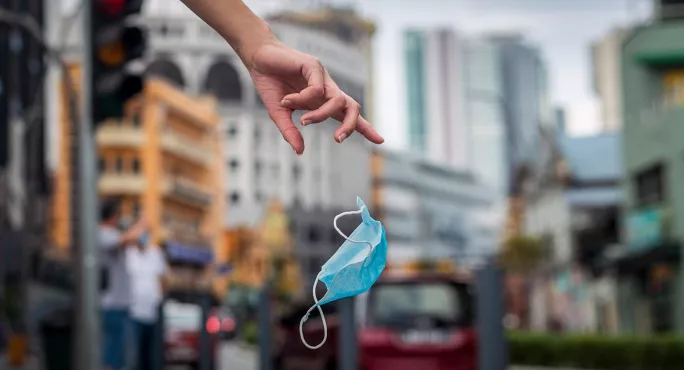Gradual removal of masks shows slowness of Covid recovery

It should be obvious by now that we will not be suddenly emerging into a post-Covid dawn at any point. The path out of the pandemic is slow and incremental and, no matter how many iterations of “Freedom Day” there are, the truth is that we may barely realise when the day comes that Covid can finally, definitively, be consigned to the history books.
Whatever your definition of the “end” of the pandemic, Covid has wreaked so much havoc on our lives that the after-effects are likely to be felt for many years to come. Indeed, historians looking back at the 1918 Spanish flu pandemic will tell you that there are likely to be “permanent implications” for the world.
The tortuous and sometimes confusing path out of Covid is epitomised by the saga of mandates on the wearing of face coverings in Scottish schools.
- Background: Face coverings not required in Scottish schools after Easter
- Flashback to February: After 16 months, masks are (sort of) coming off in Scotland
- A teacher’s view: What it feels like to take off our masks after 16 months
- A year and a half ago: Staff in Scottish schools told to wear face coverings
- Long read: Two years of Covid: the view from inside schools
When rules for teachers and senior-phase students were announced in late October 2020, they marked the beginning of various requirements to wear face coverings that, after various tweaks along the way, will finally come to an end from Easter Monday, 18 April, as first minister Nicola Sturgeon revealed this week.
But this all emerged in rather a muddled fashion. Less than a week previously, there had been reports that face coverings would still be required in secondary schools’ communal areas - they have not been a requirement in classrooms since 28 February - after the Easter holidays, and that this might remain the case all the way up until the summer holidays.
Then came the first minister’s announcement on Wednesday that legal requirements to wear face coverings in indoor settings would be replaced with guidance on a “phased basis”.
Weddings, funerals, shops and public transport were among the places Sturgeon cited, but, as Tory leader Douglas Ross pointed out, she had made no mention of schools. He asked whether the revised policy on face coverings meant that they would no longer be required in any part of a school.
The first minister then replied at length to various questions Ross had posed, but only slipped in a brief mention of schools right at the end, when she said that “we would expect the requirements in schools to lift in line with the requirements for the general population”.
Observers could easily have missed this fleeting but significant moment: the end of any requirement for face coverings to be worn in schools was being announced, after nearly 18 months.
The understated delivery of this news - in response to an opponent’s question rather than in her long Covid statement that preceded it - led to some confusion about whether face coverings would still be a requirement in secondary schools after the Easter break.
Even Sturgeon’s deputy, former education secretary John Swinney, did not seem 100 per cent confident about the government’s new policy when he was asked for clarity at the Scottish Parliament’s Covid-19 Recovery Committee on Thursday morning, the day after his boss’s subdued announcement.
He said: “My understanding is that masks will not be required in communal areas as an obligation from 18 April, but that wearing them will be recommended as something that is beneficial for maintaining some protection in place.”
In other words, the government is telling schools that it is probably still a good idea to wear a face covering in school - you just don’t have to anymore.
As we’ve seen during the pandemic, public health messages tend to work best when they are clear and unambiguous. Now, the government has effectively put the onus on schools to determine where and when face coverings should be worn.
And this is how schools - and everyone else - emerges from Covid. Not by definitely shutting the door to the pandemic, but by tiptoeing around Covid and hoping it does not find a way to sneak back into our midst.
The huge pressure borne by schools during the turmoil of the first few weeks of Covid and the lockdowns that followed is well documented, but at least there was a measure of clarity and certainty in the rules and big decisions were being made by the government at that time.
Now, more than two years into the pandemic, we find ourselves in a situation where Covid is still at large but the responsibility for deciding what to do about it is being increasingly put onto individuals and institutions such as schools.
The demands of Covid may have changed - but the pandemic will continue to exert pressure on schools for some time to come.
Henry Hepburn is Scotland editor at Tes. He tweets @Henry_Hepburn
You need a Tes subscription to read this article
Subscribe now to read this article and get other subscriber-only content:
- Unlimited access to all Tes magazine content
- Exclusive subscriber-only stories
- Award-winning email newsletters
Already a subscriber? Log in
You need a subscription to read this article
Subscribe now to read this article and get other subscriber-only content, including:
- Unlimited access to all Tes magazine content
- Exclusive subscriber-only stories
- Award-winning email newsletters



